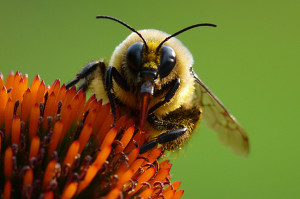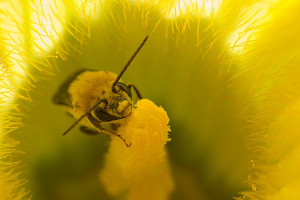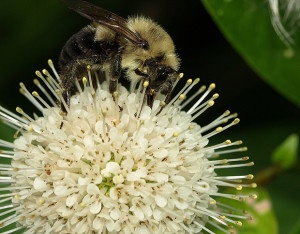We have much more to do and your continued support is needed now more than ever.
In the Buzz About Bees, Don’t Forget the Natives

The following week, some U.S. activists made headlines by demanding the government ban a class of insecticides, neonicotinoids, after learning the European Union placed a moratorium their use due to concerns the chemicals are harming honeybees. (Imported to North America during the 1600s, honeybees are native to Europe.) Such concerns are understandable. Beyond their honey-making prowess, domestic honeybees are worth tens of billions of dollars to U.S farmers and beekeepers, who truck colonies back and forth across the country to pollinate commercial crops such as almonds, soybeans and watermelon.
Why We Need Natives

Mace Vaughan, pollinator program director at the Xerces Society for Invertebrate Conservation, made precisely this point when I interviewed him recently for an upcoming story in National Wildlife magazine. Bees are by far the most important pollinators in natural ecosystems, Vaughan told me. The insects also are essential to producing more than a third of all foods and beverages humans consume. “In the United States alone, native bees contribute at least $3 billion a year to the farm economy,” Vaughan said. “We grossly overlook the critical role these animals play.”
Wild Pollinator Champs

I learned about that role a few years ago working on another article, “The Buzz on Native Pollinators,” that described research conducted by ecologist Rachel Winfree of Rutgers University. Winfree had just published in Ecology Letters results of a study finding that on 21 out of 23 farms in the Delaware Valley of New Jersey, wild bees fully pollinated commercially grown watermelons with no help from honeybees. “If we lost all honeybees in this region to colony-collapse disorder tomorrow,” she said, “between 88 and 90 percent of the watermelon crop would be fine.”
This February, Winfree and dozens of colleagues published results of much larger study in Science that looked at a diversity of fruit, seed, nut and other crops growing in 600 fields on all continents except Antarctica (where no food is grown). They found that visits by wild bees increased production at all study sites, compared with just 14 percent for managed honeybees. The upshot: Wild bees were more effective crop pollinators than were domestic honeybees.
If honeybees continue to decline—and many experts suspect they will—wild bees will become even more important in the future. Worrisome as colony-collapse disorder is, it may have had “a silver lining,” Scott Hoffman Black, the Xerces Society’s executive director, told me. “Now many more people know that their food is pollinated, and that we need native bees and other wild animals to do that.”
![]() Help wild bees by growing native plants they need to thrive, then turn your yard into a Certified Wildlife Habitat® site. This month only, Garden For Wildlife Month, NWF will plant a native tree for every property certified.
Help wild bees by growing native plants they need to thrive, then turn your yard into a Certified Wildlife Habitat® site. This month only, Garden For Wildlife Month, NWF will plant a native tree for every property certified.





















